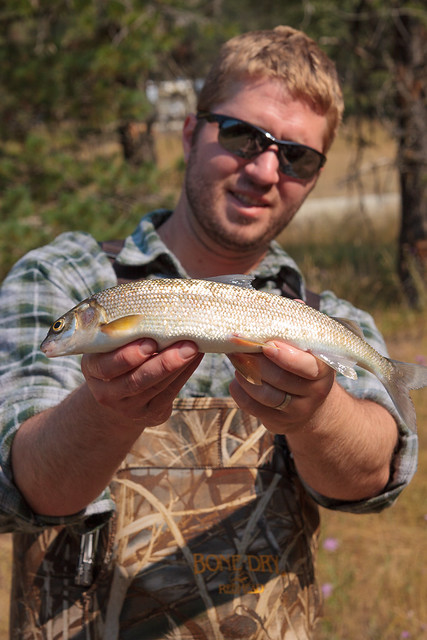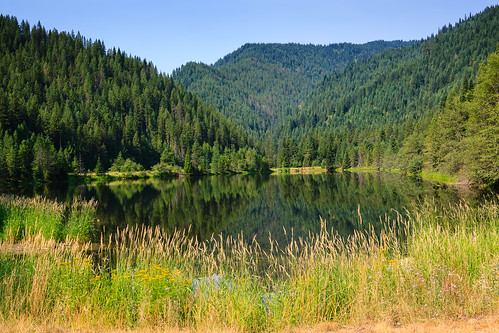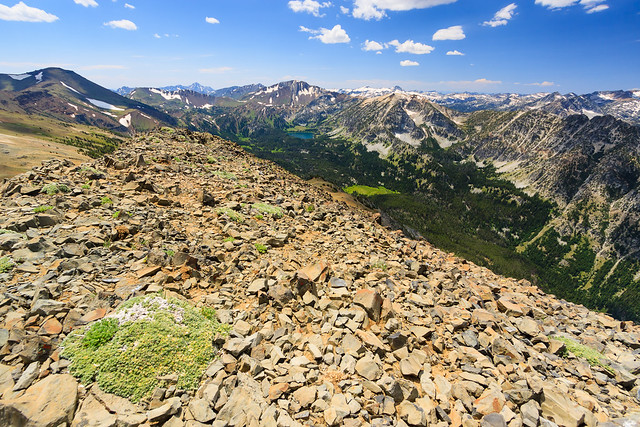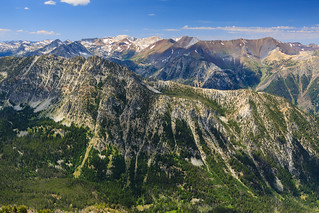There’s nothing quite like the feeling of getting that perfect cast with your fly rod, landing the fly perfectly on the water exactly where you intended it to land, and having a fish jump for it seconds later. I was in that groove Sunday afternoon where the fish were chasing after my fly, but only one actually hooked. But the thrill of fly fishing isn’t so much the catch as it is the pursuit. There’s something theraputic about standing thigh deep in running water while throwing the line back and forth, even if nothing is biting. Then again, it’s just theraputic being in the middle of nowhere away from the hustle and bustle of modern life.
After last week’s trip to the North Fork of the Clearwater, I had been itching to go back out and spend more time on the water with my rod and reel. When Tyler suggested we do another trip, I jumped at the chance and suggested we try the St. Joe river. Like the North Fork, the St. Joe winds through a narrow valley for over 100 miles from its source along the Bitterroot Divide to its end in Lake Coeur D’Alene in the town of St. Maries. In fact, one of the things that makes the St. Joe more attractable is that it sees fewer people than the North Fork, despite an easier drive. The entire road back as far as Spruce Tree campground, the end of the road, is paved. It was an unexpected surprise after spending several hours on forest service roads trying to find our way down to the river.
Normally, we’d drive to St. Maries and pick up the St. Joe River Road, but in good Idaho DOT fashion, there was road work on Friday afternoon causing a massive delay only a few miles out from St. Maries. There is a “short cut” not too far back that the GPS originally tried to route us on, but I suggested we skip because I had no idea what the condition of the roads would be like. After waiting for 20 minutes with no sign of movement, we turned around to try the path through the forest. Somewhere, we took a wrong turn because instead of travelling straight across as the map suggested we would, we ended up winding our way south back to Clarkia where we had to cross over Hobo Pass and along Marble Creek. In hindsight, we should have just taken that shortcut in the first place. So we were quite relieved to make it back to paved road and find a smooth drive back to our destination at Fly Flat campground.
The St. Joe is a smaller river than the North Fork, at least half the width and most of it fairly flat and shallow, but there are some deep canyons with deep pools and lots of fish. Unfortunately, they weren’t biting much. I think Dan and Tyler each caught about 5 fish on Saturday, most of which were in the 6-inch range. I caught none. We returned to camp and then headed upstream for an evening catch where Dan pulled in two nice sized cutthroat right away with his spinner, but Tyler and I weren’t getting any bites with flies.
Part of my problem is that I spent a good chunk of the day tying tippet. Several times, I got my line tangled or snagged and lost my fly or part of my leader. So finally, on Sunday, I cut off a twisted portion of my leader and tied on a fresh length of tippet and was having much better luck. I still lost a few more flies, one to grass, and another to a fish. We first started Sunday by heading into a deep gorge full of deep pools. Since it was too deep to wade, we had to fish from the bank, and in such a confined space, I was having trouble getting good casts. So after losing a fly to the grasses, I called it quits and headed upstream where the river was more open. This is where I caught my one and only fish of the trip, and upon releasing it, lost the fly after another cast. I suspect that the fish had chomped on the line by the hook, creating a weak spot in the knot. After that, I was getting bites, but no catches.
The St. Joe is beautiful country with great seclusion, scenery, and fishing. I can’t say whether I like it over the North Fork because both rivers offer a spectacular experience. I’m glad that I have such terrain close by and I’m looking forward to more visits in the future. One of these trips, I’ll actually take some time to photograph the area as well.














